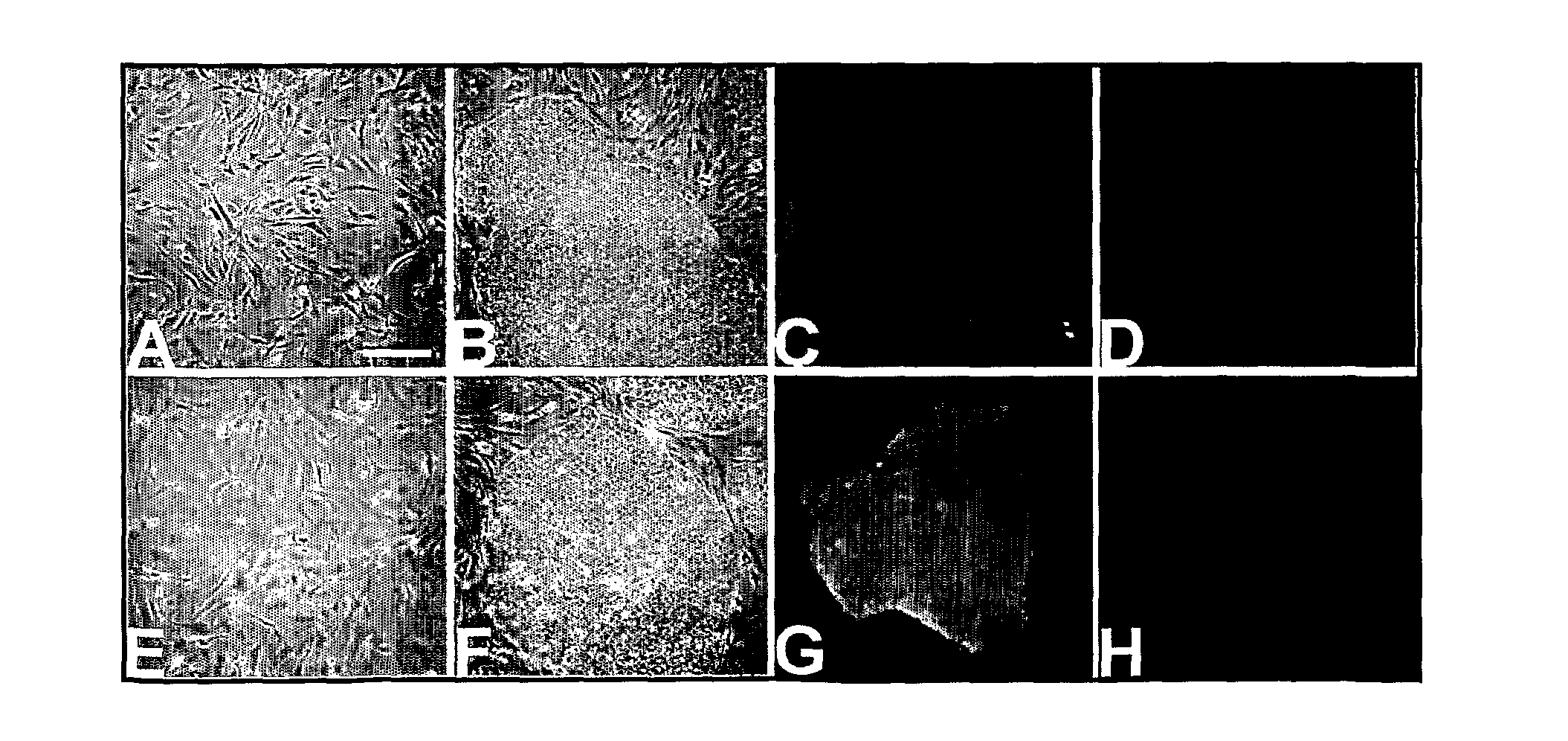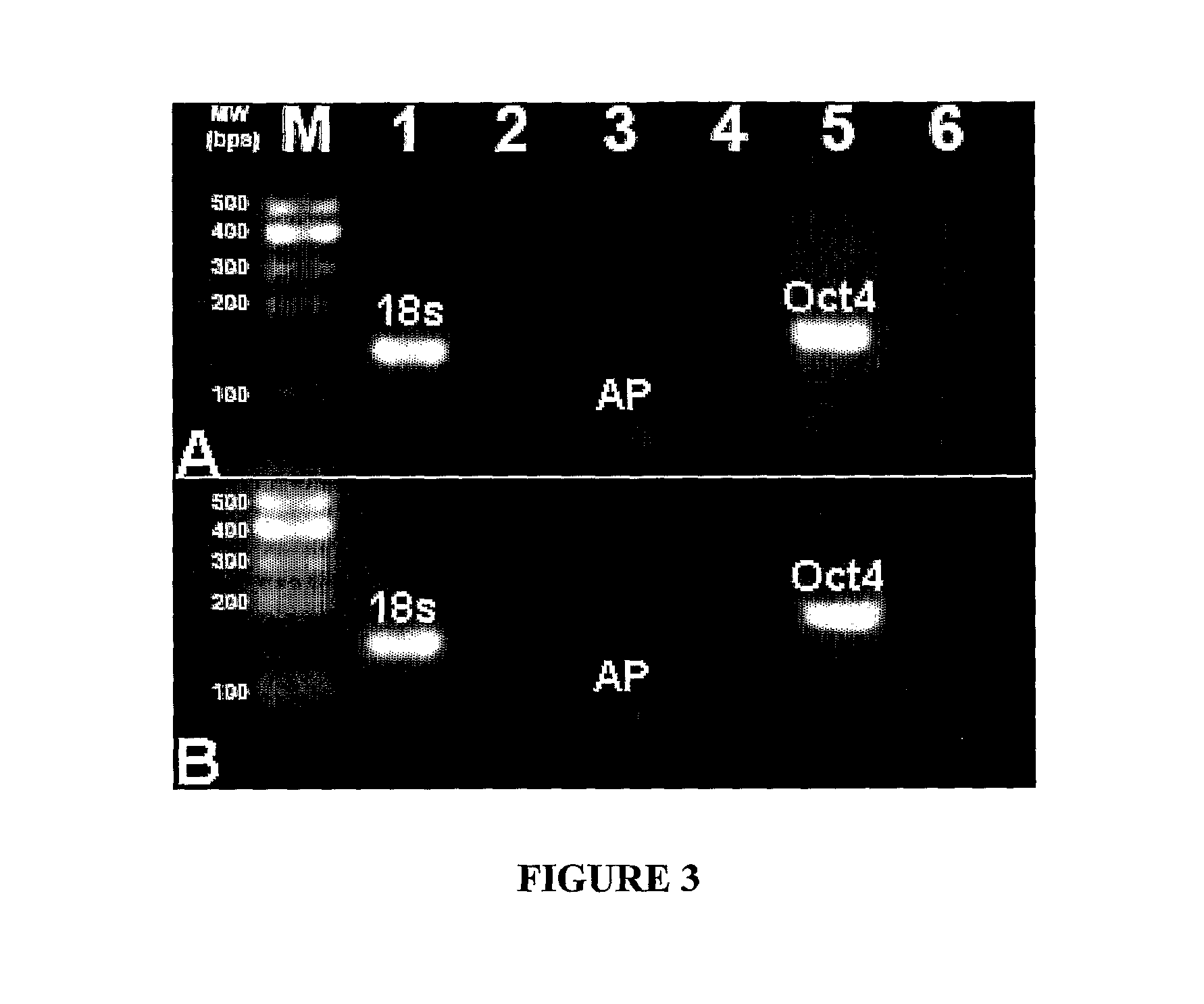Feeder cell-free culture medium and system
- Summary
- Abstract
- Description
- Claims
- Application Information
AI Technical Summary
Benefits of technology
Problems solved by technology
Method used
Image
Examples
example 1
Analysis of the Human Embryonic Stem Cell In-Vitro Micro-Environment
Materials and Methods
Mouse Embryonic Fibroblast Cell Culture
[0188]MEFs (SCRC-1046 cell line, Cryosite, Lane Cove, Sydney, NSW, AUS) were expanded to passage 6 on 80 cm2 culture flasks (Nalge Nunc International, Rochester, N.Y., USA) using 85% Dulbecco's Modification of Eagle's Medium (DMEM) (Invitrogen, Mount Waverley, VIC, Australia) supplemented with 10% fetal bovine serum (FBS) (Invitrogen), 2×10−3 M L-Glutamine (Invitrogen) and 1000 IU / mL penicillin / streptomycin (Invitrogen) in 5% CO2 at 37° C. Mitomycin-C (Sigma-Aldrich, Castle Hill, NSW, AUS) was subsequently added to the flasks containing the MEFs and the cells were incubated at 37° C. in 5% CO2 for 2.5 to 3 hrs. Culture dishes (10 cm2) (Nalge Nunc International) were then coated in 0.1% gelatine (Sigma-Aldrich) for a minimum of 1 hr before the addition of the MEFs. MEF cells were seeded 20,000 cells / cm2 onto 0.1% gelatin (Sigma-Aldrich)-coated 10 cm2 (Nalg...
example 2
Proteomic Analysis of Media Conditioned by Keratinocytes Cultured In-Vitro
[0220]This study aimed undertaking a comprehensive examination of the keratinocyte in-vitro micro-environment. In particular, a proteomic approach was adopted to identify the critical factors produced by the feeder cells that are required for keratinocyte growth. Furthermore, a serum-free media as described above, which is fully defined, and has minimal protein content was utilised. The minimal protein content of this serum-free media provides a significant advantage in that it will not “mask” the critical factors secreted by the feeder cells which may be important for supporting keratinocyte cell growth. Additionally, serum-containing media normally requires a pre-processing step before proteomic analysis, such as the “Multiple Affinity Removal System” (MARS) (Agilent Technologies). This MARS immuno-depletion technology involves the removal of high abundant proteins from serum-containing media, which could re...
example 3
Feeder- and Serum-Free Growth of hES Cells
[0243]hES cells were grown and tested with the following medium formulation 1 ug / mL IGF-I / 1-64VN chimeric protein, 0.1 ug / mL bFGF, 35 ng / mL Activin-A and 40 μg / mL laminin.
[0244]Immunofluorescence (IF) was conducted using antibodies directed towards Oct4, TRA1-60, SSEA-4, SSEA-1 antigens. The IF studies (in FIG. 8) demonstrated expression of Oct4, TRA1-60 and SSEA-4 but only low expression of SSEA-1. The hES cells also presented with a large nucleus to cytoplasmic ratio indicative of a hES phenotype.
[0245]Rex1 is an anomaly this result demonstrates massive down regulation within our culture system. However, when Oct4 and Nanog were examined these amplicons revealed almost a 2 fold increase in expression within our culture system (see FIG. 9).
[0246]These data taken together suggest that the system described can indeed maintain these cells in an “undifferentiated state”.
[0247]Throughout the specification the aim has been to describe the prefer...
PUM
 Login to View More
Login to View More Abstract
Description
Claims
Application Information
 Login to View More
Login to View More - R&D
- Intellectual Property
- Life Sciences
- Materials
- Tech Scout
- Unparalleled Data Quality
- Higher Quality Content
- 60% Fewer Hallucinations
Browse by: Latest US Patents, China's latest patents, Technical Efficacy Thesaurus, Application Domain, Technology Topic, Popular Technical Reports.
© 2025 PatSnap. All rights reserved.Legal|Privacy policy|Modern Slavery Act Transparency Statement|Sitemap|About US| Contact US: help@patsnap.com



